Zenario 10.1
Version 10.1 of Zenario is now available for Tribal-hosted customers. It will be publicly available soon.
Here are the main features.
Major changes
Nests and slideshows now more mobile-friendly
We have re-organised the system of Nests and Slideshows. There are now three kinds:
- Nests — Used for a nest with multiple slides. SEO friendly when used on public pages
- Ajax Nests — Used for a nest with one or multiple slides. Only one slide is loaded on the client browser at a time, and transitions between slides are implemented using AJAX (server-side calls). This type allows use of Conductor for advanced nest configurations such as to build multi-panel and multi-level dashboards
- Slideshows — Used typically for animated image-based hero graphics, but still with many further customisation options.
The key improvement in search engine terms is that regular nest slides are preloaded on the client browser, and transitions are implemented using JavaScript. This means their their content can be read by search engine bots, and so all slides of a regular nest can be indexed.
Conductor-based nests
You can now make Conductor-based nests which have multiple slides, and use a Banner plugin on a slide to link to another slide.
Accordions!
Zenario now supports a nest-based way of creating "accordions". The final result might be like this:
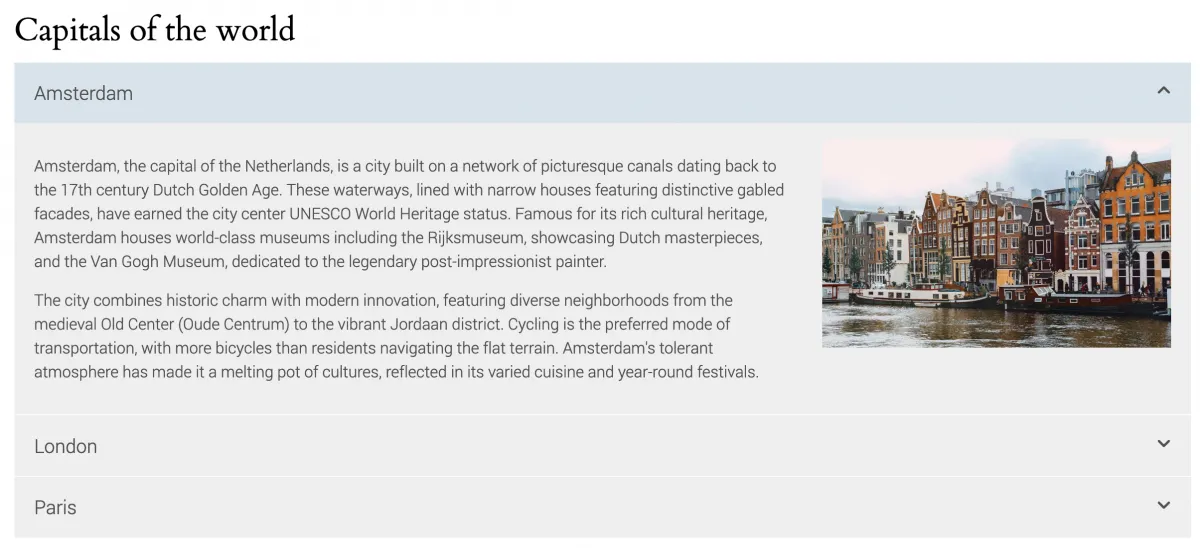
To create this, the nest is created like this:
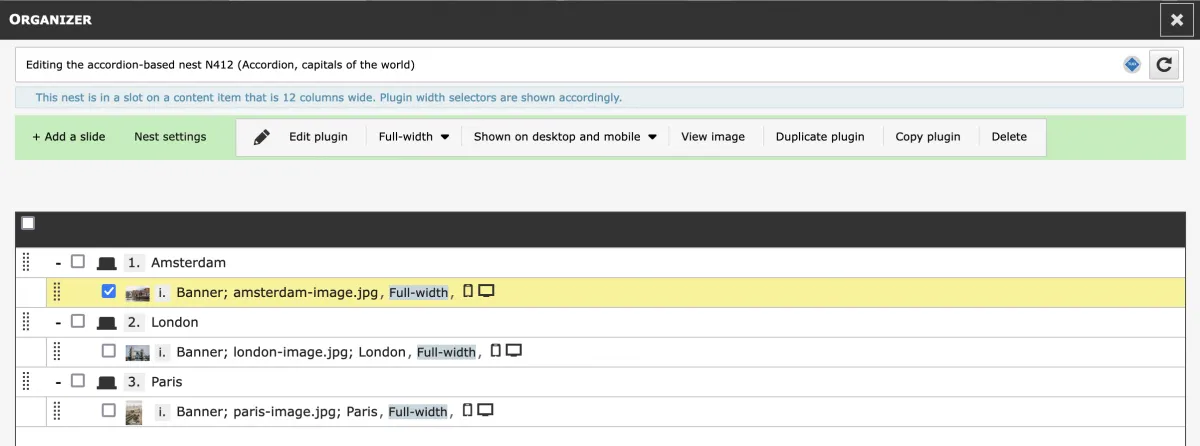
The new 'Appearance' setting in the Nests plugin allows content to be displayed as accordions. This feature enables you to organize content into multiple collapsible sections.
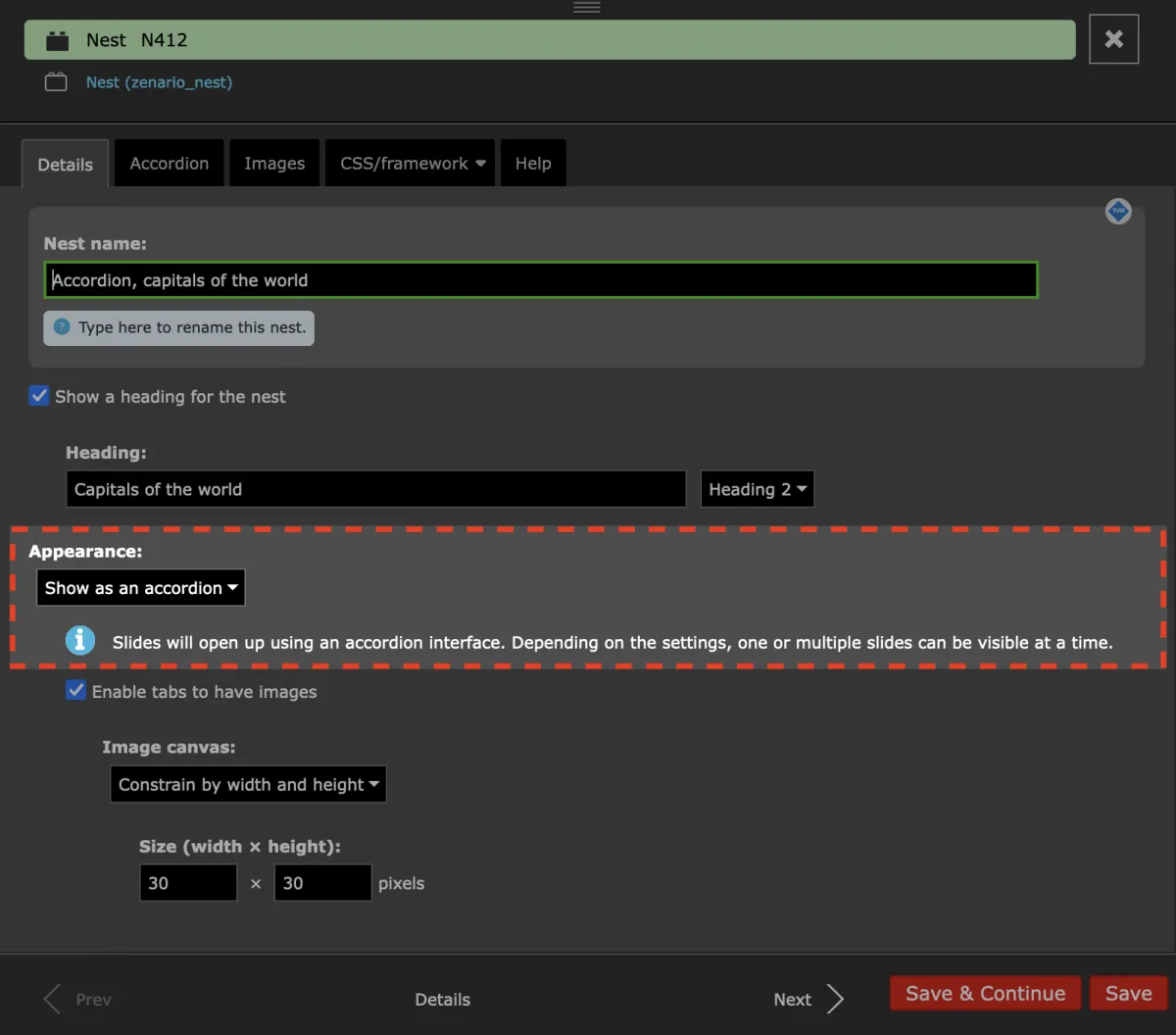
The 'Accordions' tab provides several customization options, allowing you to control whether the first slide opens automatically on page load, whether all slides can be closed at once, and whether multiple slides can be expanded simultaneously.
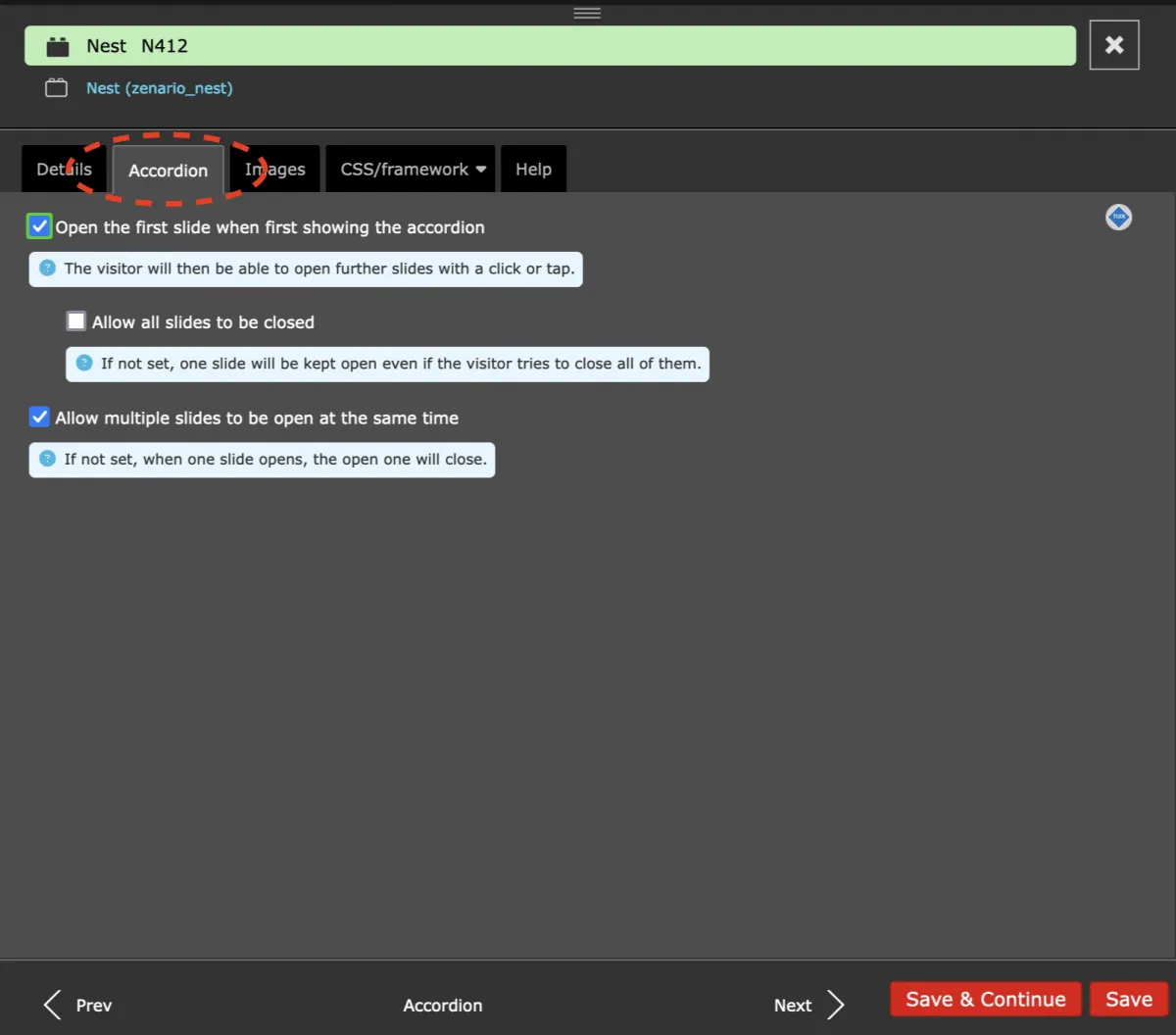
Image handling with WebP
In Zenario 10.1 we're now using the WebP image format for all images in the public/ directory.
Although Zenario accepts original images in PNG and JPG format, all images that are going to be delivered to a visitor's browser are re-formatted into WebP format for higher performance.
The migration script to migrate to Zenario 10.1 will generate a WebP version of every publicly accessible image on the site. On a site with large images, this may take some time, but after that one-off delay performance should be faster and disk usage should be reduced compared with 10.0.
Note that very large images (over 3,000 px in either dimension), will be left in their original format, as the performance gain is then quite minor.
Other image-related changes
There's now a better system for auto-generating ALT tags for images when images are uploaded. (The ALT tag can still be edited by an administrator as required).
Document storage in the docstore
In Zenario 10.1 we've changed the format of the directory structure in the docstore directory.
Until Zenario 10.0, files were stored in its sub-directories using a naming convention where the folder name is the filename's short checksum.
Starting in 10.1, Zenario uses a sub-directory that groups files according to how they are used, their “usage”. It now has an extra level of sub-directory, in the naming convention “usage/[filename-checksum]/”.
This migration script will attempt to change the docstore at / to the new naming convention. (It will first perform a check to ensure it is writable).
Any sub-directories that do not have corresponding “usage” entries in the database will be moved into a new subdirectory called “_uncategorised/”.
There is a warning on the admin login/diagnostics page to warn that changes are about to be made to the structure of the docstore.
Admin toolbar
We have improved the design of the admin toolbar so that there's more real estate for it to accommodate a larger number of languages. For example, a site can more easily be built for EU countries with 26 languages.
Slot Inspector
When using "Tools" view, if an administrator now wants to add something into slot, they now click "Insert plugin/nest/slideshow", and then a further interface takes them through the process of creating and/or inserting a plugin, nest or slideshow into the slot.
Similarly, there is now a Copy action to copy a plugin, nest or slideshow to another slot.
Staging mode
When viewing a page in staging mode, the small orange panel for invitees now has a link to the content item (which is useful if the invitee is also an administrator).
Document content items
Document content items now have retina quality image support on their thumbnails.
Forms
In the Forms editor, we have improved the order of fields that can be added from the left-hand side.
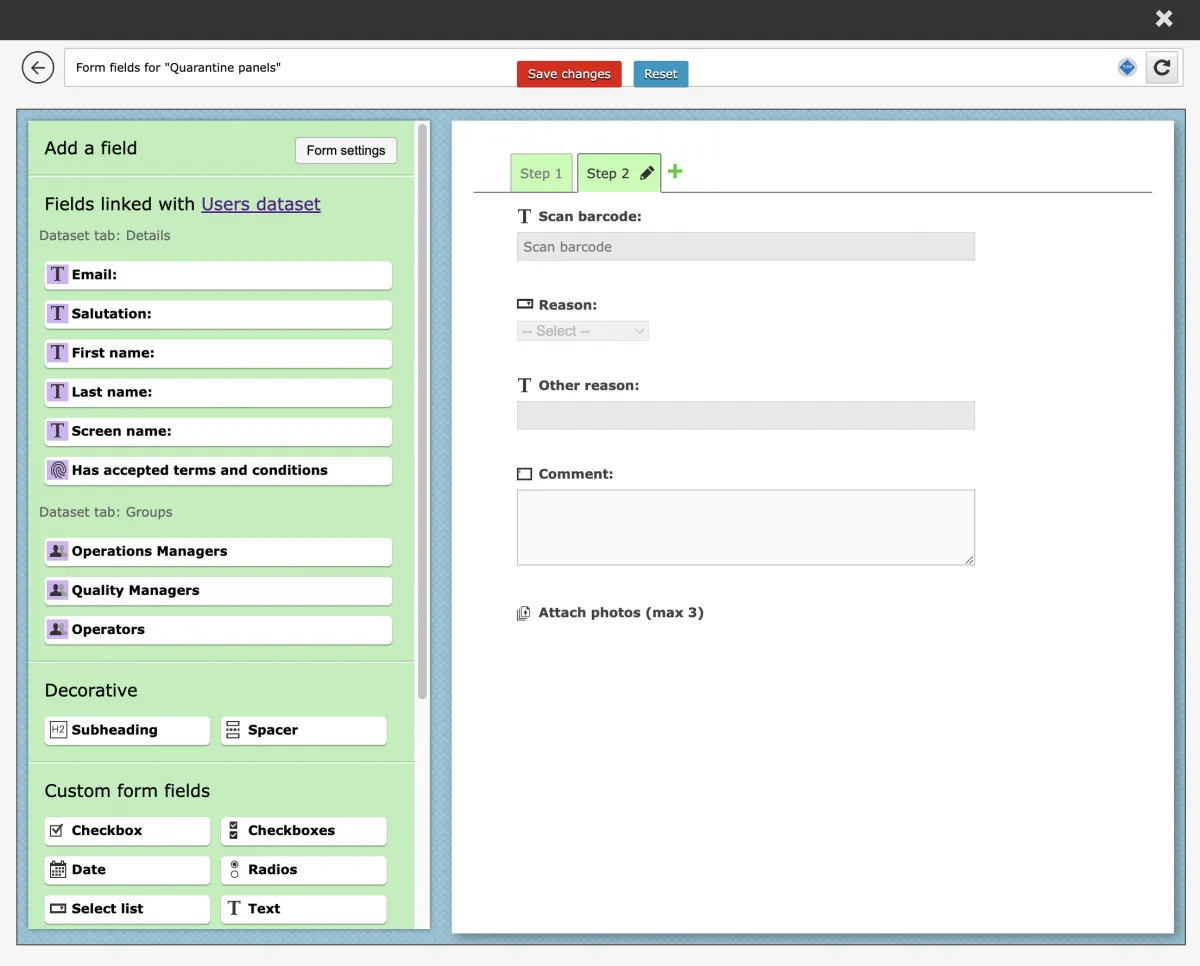
When a form response causes Zenario to send an email, the Sent Email Log now shows the email that was sent, and which form response generated it.
When using the Forms editor, and specifying that a field's visibility should be dependent on a second field, then we provide better information and warnings under certain conditions.
It is now possible to delete a form from the archived forms panel.
It is now no longer possible to edit the settings or fields of an archived form.
In the Forms editor, there is now validation to ensure that calculated fields cannot be placed within a repeat block, which would cause a bug.
When a form response causes Zenario to send an email, the Sent Email Log now shows the email and which form response generated it.
It is now no longer possible to edit the settings or fields of an archived form.
Where a form has calculated fields (i.e. a numeric field calculated on the fly from another field), we have now fixed an occasional difference between the JS and PHP calculations.
There is now validation to ensure that calculated fields cannot be placed within a repeat block, which would cause a bug.
Hierarchical documents
Fixed a bug whereby when a hierarchical document had multi-checkbox data, the data failed to be cleared from the database when the document was deleted.
Locations
When editing a location and selecting an image from the image library, an admin may only select images that are public (not private).
Organization Manager
There has been some inconsistent wording in modules related to organizations, companies, and customers. We have improved the wording to now refer consistently to "organizations" (with the US-style spelling).
Extranet sites
The Registration form plugin now has better support for custom fields, by making a "picker" button available so that the administrator can pick custom fields from the Users dataset and make them appear on the registration form.
User timers can now be extended at any time, and are no longer restricted to the last 30 days of a user's timer (i.e. membership or subscription).
Datasets
We have fixed a but where multiple-checkbox fields no longer show indexing options (which had no effect).
E-Commerce
For e-commerce sites, there is now a better system of handling addresses. On the checkout page, a customer can now select which address to use for the purchase, out of either home or business/alternative address, which the customer will have set up in their profile. It is still possible to select a separate address for delivery in the case of physical products.
Organizer
Organizer panels that show a list of plugins now use three lines to give more clear info about the plugins.
We have improved the navigation in Organizer with respect to Users, and now it is easier to find your way around.
Deletion of logged errors from the error log is now handled by the data protection cleanup scheduled task. This is more efficient.
Other changes
The Promo Menu plugin now has the capability of showing the promo image to the left or to the right.
The Email Template Manager module has been removed, and its functionality has been absorbed into Zenario Common Features module.
When editing a Location and selecting an image from the image library, an admin may only select images that are public.
We fixed a bug whereby when a hierarchical document had multi-checkbox data, the data failed to be cleared from the database when the document was deleted.
We have fixed a bug, whereby if a site had both a primary domain and an admin-specific domain set, a redirect would keep occurring to the primary domain even when the administrator was logged in.
Document Envelopes now have their own "usage pot" for images. There is now better control over validation of Codes, when creating/editing a Document Envelope.
When in Organizer and viewing information about modules, it is now easier to see information about modules.
Deletion of logged errors from the error log is now handled by the data protection cleanup scheduled task.
Error emails are now more informative and include the referrer, if present.
Notes for customers using Newsletters
If you have previously sent a Newsletter with images linking to PNG or JPEG images in the public/images/ directory, and you every delete those directories, then those links will become broken and stay broken as Zenario will no longer recreate them.
Addendum 7 April 2025
It is possible for a bot attack or a pentest on a Zenario site to generate support email errors containing:
session_regenerate_id(): Session ID cannot be regenerated when there is no active session
in /var/www/zenario-source/Zenario-10.1/zenario/autoload/cookie.php
at line 168
The error emails are a result of a small bug in the session handling code, and these cause error emails to be sent. This is now fixed.


